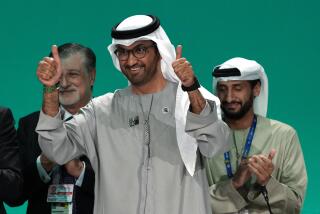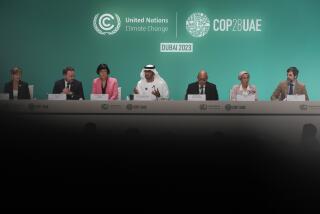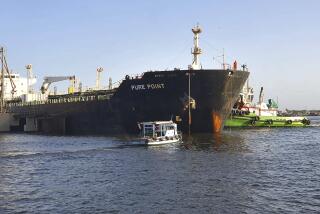OPECâs Grip on Oil Prices Holds Firm
In the wake of last yearâs free-fall in the price of oil, both OPEC and its traditional leader, Saudi Arabia, appeared in disarray. Even the cartelâs December agreement to boost prices and cut production seemed an exercise in wishful thinking.
But as the OPEC ministers prepare for their midyear meeting June 25 in Vienna, their principal problem--other than military tension in the Persian Gulf--might be complacency arising from their own surprising success in managing the worldâs oil markets so far this year.
Already, there are fresh signs of excess production by some members of the Organization of Petroleum Exporting Countries and scattered demands to raise prices above the $18-per-barrel level that the cartel already has achieved. Economists say that such impatience could undermine oil prices all over again.
The Saudis, by most accounts back in command of OPEC strategy, appear to agree. And the organization is expected to reject such demands and hold to the plan put in place last December, calling for a nominal third-quarter production increase but no change in official price.
âMost of the members are producing at levels they feel comfortable with, and there is a sense that their situation can only improve as demand increases later this year. They know that if they tamper with the agreement, it will open a can of worms that will be hard for them to digest as an organization,â says Bijan Mossavar-Rahmani, assistant director and OPEC analyst at the Harvard Energy and Environmental Policy Center.
Saudis Get the Credit
Another student of OPEC, economist Philip K. Verlager of the Institute for International Economics in Washington, concurs:
âIf theyâre smart, theyâll make it short and sweet and get out of Vienna as fast as possible.â
Apparently chastened by the self-induced price collapse that devastated the economies of its member nations, OPEC has convinced many observers that it has indeed gotten smart. And much of the credit is being given to the Saudis and their new petroleum minister, Hisham Nazer.
The longtime planning minister, Nazer was chosen last September to replace Sheik Ahmed Zaki Yamani in what has been one of the world economyâs most influential posts. Yamani presided over OPECâs rise to power during more than two decades until being fired after a series of disputes with King Fahd. It was a time when Iran appeared to be gaining power within OPEC and the Saudis, with more oil than anyone else, appeared to be confused about oil policy.
Nazer remained in the background during the OPEC meeting last December that forged an agreement to cut crude oil production by about 7% to 15.8 million barrels a day, and fix per-barrel prices at an average of $18, compared to then-prevailing prices of $13 to $14. It was an agreement with so many weak links--notably the refusal of Iraq to abide by it--that OPECâs customers, the worldâs oil companies, doubted it would work.
But after initially balking at long-term contracts to buy oil at an official price that they didnât believe would hold up, oil traders gradually came into the fold when key OPEC members refused to offer discounts and told customers to take it or leave it--a position that was critical to the success of the agreement.
And when prices threatened to weaken in the spring as seasonal demand fell, the Saudis--though refusing to lock themselves again into an official role as OPECâs âswing producerâ--temporarily slashed their own production more than 1 million barrels a day below their quota. That eased fears of a renewed flood of oil, supported the $18 price and convinced oil markets of the Saudisâ resolve.
After a glut drove down crude oil prices from $30 to $10 a barrel in the first half of 1986, the idea was to bring the worldâs oil supply and demand into a balance that would result in a stable price high enough to satisfy the economies of OPECâs disparate members and head off political unrest.
But the price had to be low enough to encourage the industrial world to start using more oil, reverse the energy conservation mentality that had put OPEC on the defensive since 1981 and make it unrewarding for the worldâs oil companies to explore for new sources of petroleum.
OPEC bargainers thought $18 a barrel would fill the bill, and the December pact quickly brought prices to the $18 range for OPEC crudes where, after several volatile months, it has settled. By holding the line--Saudi King Fahd has said he hopes to see oil prices remain in that range for two years--most economists and oil company executives believe that OPEC can regain its dominance within a few years because non-OPEC oil production will drop and be replaced by the Middle Eastâs abundant, cheaply produced oil.
Economist Convinced
âTheyâve held this thing together for the toughest part of the seasonal downswing in demand,â says William D. Hermann, chief economist at San Francisco-based Chevron, the third-largest U.S.-based oil producer and a major Saudi customer.
âI guess we underestimated the religion they got from the low prices last year. Iâm getting more and more to the point where I think thereâs a possibility of holding these prices for a couple of years. My guess is weâll see demand for OPEC oil at 20 million barrels by 1990 or 1991,â Hermann said.
As recently as 1979, the world needed 31 million barrels of OPEC oil each day. That plummeted to 16 million barrels by 1985. Now itâs going back up.
In the United States alone, overall oil demand already has risen by 200,000 barrels per day over the past year, while oil production has fallen by 800,000 barrels. That has created a need for another 1 million barrels a day from other countries, and most of the need is being filled by OPEC members. Imported oil, which fell from 47% of U.S. consumption in 1979 to 29% in 1985, has surged to about 40%.
By this fall, according to an estimate by the Salomon Bros. investment firm in New York, world demand for OPEC oil will be up to 17.5 million barrels per day at prices more than $4 a barrel above last yearâs average. That sort of arithmetic eventually would reverse the financial debacle that Salomon Bros. says amounted to $55 billion in lost OPEC oil revenue last year.
âIt is critical to recognize that (OPEC) has been transformed by its recent experience,â says Paul D. Mlotok, Salomonâs international oil analyst. âIts future ability to affect markets will be greater and more consistent than it has been in the past.â
One quick result has been a rise in gasoline prices and inflation, though both remain moderate by pre-collapse standards. After plunging to an average of 85 cents a gallon in 1986 from $1.20, U.S. gasoline prices have bounced back to an average of 99 cents a gallon since the December OPEC accord, according to the Lundberg Survey.
Pivotal Agreement
Mlotok and others credit the Saudis and Nazerâs quiet diplomacy with plugging holes in the complicated December agreement, especially the refusal of Iraq to go along with the pact and the diametrically opposed motivations of OPECâs warring senior members, Iraq and Iran.
Several Middle East experts now say that Saudi Arabia effectively co-opted Iran by bringing it back into OPECâs inner circle last fall, while the Saudis used their long-standing financial support of Iraqâs war effort to keep the Iranians in line. Iranâs agreement to accept Iraqâs refusal to join in the quota was pivotal to the hard-won December accord.
In return, Saudi Arabia has managed to delay the opening of a key new Iraqi oil pipeline across Saudi territory--a pipeline that not only would enrich Iraqâs war coffers by $9 million a day but also undermine OPECâs quota ceiling and weaken prices by adding 500,000 barrels of crude daily to world markets. The delay until this fall, from its expected opening this month, has been officially explained as the result of technical problems in completing the pipeline to the Saudi port of Yanbu.
âI donât believe the technical stories. It was part of the Saudi strategy of appeasement with Iran,â says Harvardâs Mossavar Rahmani. âIt camouflaged their managing of the quota process. The Saudis keep prolonging the opening of the pipeline, but in a way they also use this as a bargaining chip to make sure the Iranians behave themselves. The Saudis have constrained the behavior of both countries, and that strategyâs been very effective.â
Meanwhile, their steep cut in March production, reportedly to below 3 million barrels per day, compared to the official Saudi quota of 4.1 million barrels, headed off a spring drop in prices that several skeptics had predicted would cause the agreement to unravel. It also gave confidence to smaller OPEC members, said Hisham Naggar, director of the Middle East and Africa service at Wharton Econometrics in Bala-Cynwyd, Pa.
âOnce the other OPEC producers were assured of a price floor by Saudi Arabia temporarily acting as swing producer, they felt comfortable with abiding by their own quotas,â Naggar said.
Another reason for the skepticism over the December accord was its presumption to fix both production and price, rather than let one determine the other according to the law of supply and demand. The Saudis readily abandoned that notion and gave priority to maintaining the $18 price when demand fell in the spring. Now, the original formula--whereby 15.8 million barrels a day plus the expected several hundred thousand barrels of so-called leakage would support an average $18 price for the more than 100 grades of OPEC crude oil--appears to have been about right.
âThe fact is, what they did in December was a pretty good forecastâ of supply and demand, Mlotok says.
Nazerâs role in all this remains a subject of debate, but lately he is getting credit for being more than King Fahdâs mouthpiece. He is described as an effective behind-the-scenes manager and diplomat who, among other things, has won production restraint from Norway and other non-OPEC producers that has kept an estimated 400,000 barrels a day off the market. Mlotok, recently returned from a tour of the Saudi oil community, says it is a mistake to underrate Nazer.
Economist Verlager agrees: âNazer seems to be moving very methodically, if less theatrically (than Yamani), along a path that will mean more long-term stability for Saudi Arabia. Of course heâs carrying out the kingâs orders, but whoâs telling the king whatâs going on?â
The successes of the past six months notwithstanding, OPEC faces almost as many pitfalls today as it did last winter. The 13 nationsâ oil revenue remain far below the level of two years ago; there is still too much oil on the market; the Iran-Iraq war rages on, and the completion of Iraqâs big new pipeline has been delayed only until fall. Meanwhile, the weakened dollar means that $18 for a 42-gallon barrel doesnât buy as much as it used to.
In OPECâs rough-cut world, the daily official production ceiling of 15.8 million barrels established in December has actually meant perhaps 16.6 million barrels of crude oil each day until recently. The extra oil has come from Iraq, an excluded neutral zone adjacent to Kuwait, and the usual low-level cheating on authorized quotas by smaller, weaker OPEC members such as the United Arab Emirates that has long been tolerated by the cartel as a whole.
Ceiling Increased
The December agreement, anticipating that a normal second-half rise in oil usage would increase the worldâs appetite for OPEC oil, provisionally raised the production ceiling to 16.6 million barrels a day for the third quarter and 18.3 million barrels for the fourth quarter.
Last week, the Middle East Economic Survey estimated that true OPEC production in May rose to about 17 million barrels a day and is continuing at that level in June, while demand has been seasonally low. While some say the market can absorb that much oil, even the most bullish analysts believe that OPEC wonât proceed with the planned fourth-quarter rise in production.
âThere are definitely some bumps in the road,â says analyst Bryan Jacoboski of Paine Webber in New York, a regular observer at OPEC meetings. âThereâs more political cohesion than thereâs ever been in OPECâs history, but the economics are not that encouraging.â
Fereidun Fesharaki, head of the energy section at the East-West Center in Honolulu and former OPEC delegate and adviser to Iranâs prime minister under the Shah, predicts a $2-per-barrel drop in prices later this summer on world markets because of the overproduction.
Nonetheless, the consensus is that the oil cartel--notably Saudi Arabia--has shown it can deal with such swings in supply and demand. And with world oil company inventories as of June 30 expected to be at their lowest for that date since 1973, according to recent International Energy Agency estimates, OPECâs customers will be particularly in need of oil as winter approaches and demand climbs.
Almost as important is the industryâs perception, according to Verlager, that prices will remain steady--and thus will have no motive to put off buying oil. As evidence, he notes a 17% falloff in the trading of oil futures contracts on the New York Mercantile Exchange since April.
âIf a company is certain that prices will be stable, he has no need to engage in futures trading,â Verlager says.
More to Read
Inside the business of entertainment
The Wide Shot brings you news, analysis and insights on everything from streaming wars to production â and what it all means for the future.
You may occasionally receive promotional content from the Los Angeles Times.










